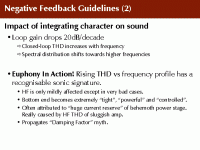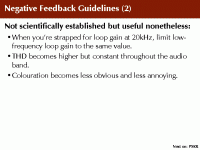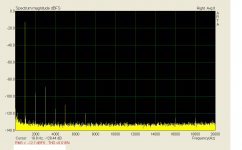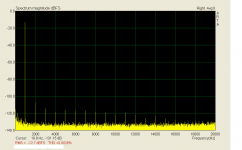listening evidence
Here is listening evidence from Bruno Putzeys, http://en.wikipedia.org/wiki/Bruno_Putzeys presented on 123rd AES convention 2007
Are you satisfied?
But since you have put up not one iota of listening evidence in support of that sweeping generalisation, Jan would be entirely reasonable to ignore it.
Here is listening evidence from Bruno Putzeys, http://en.wikipedia.org/wiki/Bruno_Putzeys presented on 123rd AES convention 2007
Are you satisfied?
Last edited:
listening evidence: attachments
Attachments
Last edited:
It's often said in the context of
op-amps that why bother not using them since
they are in the recording chain.
BUT ......
If 11 op-amps are put in series, the percieved
signal degradation between the output of
#10 and #11 is the same as between 0 and #1 .....
I have often wondered about this. It may be that your explanation is the correct one.
Another idea is that there are still a lot of recording consoles in use with discrete circuits or even (gasp!) tubes.
Another idea is that even though the recording console uses crappy little op-amps that screw up the sound, that the signal through each of the 128 channels (!) is limited to a single instrument. In this case the op-amp inflicts less audible damage than it would in the playback chain where it has to handle 100 or more instruments at once in an orchestral recording.
I really don't know.
It would be fun to have the time and money to find out the answers.
In might be important to note why VIDEO amplifiers have high open loop bandwidth with similar circuitry as audio amplifiers that are slightly configured to have higher feedback at low frequencies. WHAT is the video circuit sensitive to?
Geez, John.
You sure have a way of making me feel dumb.
Same with Barrie Gilbert. (Even though I think he has no idea about how things sound in the real world. He probably thinks I am a deluded fool so that probably makes us even. Except that he can still make me feel dumb about theoretical electronics.)
ooh this is good - our no feedback, analog audiophile guru endorsing a citation of someone listening to a CD with a Class D amp as evidence for their low loop gain preference?
"...secured some research money so that Putzeys could further refine his class-D amp design. The goal was an amp module that would be easy to manufacture and suitable for a wide variety of audio applications, from mass-market to high-end. It had to be compact and have the same output impedance and power-supply requirements as a conventional amp. And it had to be cheaper and sound better. ”The idea was that there would be no excuse for not using it,” Putzeys recalls.
This time, it took him eight months. He went through four generations of circuit boards without listening to any of them. Instead, he connected each board to an audio analyzer and then rejected it because the results on the analyzer weren’t what he wanted.
The fifth iteration, though, looked good. Just before Christmas 2001, he brought a pair of the amps home and connected them to the speakers in his living room. He put on a CD of Spanish classical music and selected a song by the 18th-century composer Juan Francés de Iribarren, ”Viendo que Jil, Hizo Rayo.” He settled back in a chair and listened. It took him just a few seconds to reach a conclusion: ”Straight in the bull’s-eye.”
...
And when he can, he also listens to his own stereo setup, usually at night. The system is beautiful in the way that only a DIY audiophile’s can be; no rich poseur would ever wind up with something like this.
... His power amplifiers, small, elegant, and shiny, are a pair of monoblock units (a separate unit for the left and the right channel); they were prototypes for the MP150 amplifier from the Netherlands audio company Kharma International. Inside each box is, of course, a UcD module.
...
The system is marvelous, if ungainly. And it nicely exemplifies Putzeys’s own credo about hi-fi components.
"Stereo replay never actually reproduces a musical event,” he says. ”The only thing you can hope for is a credible illusion. But it can be a very nice illusion.”
"...secured some research money so that Putzeys could further refine his class-D amp design. The goal was an amp module that would be easy to manufacture and suitable for a wide variety of audio applications, from mass-market to high-end. It had to be compact and have the same output impedance and power-supply requirements as a conventional amp. And it had to be cheaper and sound better. ”The idea was that there would be no excuse for not using it,” Putzeys recalls.
This time, it took him eight months. He went through four generations of circuit boards without listening to any of them. Instead, he connected each board to an audio analyzer and then rejected it because the results on the analyzer weren’t what he wanted.
The fifth iteration, though, looked good. Just before Christmas 2001, he brought a pair of the amps home and connected them to the speakers in his living room. He put on a CD of Spanish classical music and selected a song by the 18th-century composer Juan Francés de Iribarren, ”Viendo que Jil, Hizo Rayo.” He settled back in a chair and listened. It took him just a few seconds to reach a conclusion: ”Straight in the bull’s-eye.”
...
And when he can, he also listens to his own stereo setup, usually at night. The system is beautiful in the way that only a DIY audiophile’s can be; no rich poseur would ever wind up with something like this.
... His power amplifiers, small, elegant, and shiny, are a pair of monoblock units (a separate unit for the left and the right channel); they were prototypes for the MP150 amplifier from the Netherlands audio company Kharma International. Inside each box is, of course, a UcD module.
...
The system is marvelous, if ungainly. And it nicely exemplifies Putzeys’s own credo about hi-fi components.
"Stereo replay never actually reproduces a musical event,” he says. ”The only thing you can hope for is a credible illusion. But it can be a very nice illusion.”
I also feel pretty 'dumb' around Barrie Gilbert, but I always try to learn from him, what I can, and ignore what he thinks of me, on occasion. I will NEVER forget the 'look' he gave me in 1974 at an IEEE ISSCC convention when I tried to talk to him about TIM. Of course, 20 years later, all was well, and TIM was OK, even PIM was OK with him. Live and learn, everyone.
I don't think global feedback is bad or messes up the sound. In fact I believe that, in general, it will improve things.
I don't doubt that when comparing an amp with little or no GNFB to one with high GNFB, the high-feedback design will sound worse.
However this isn't a fair comparison - the problem with the high-feedback amp is not that feedback has somehow "spoiled" it, but simply that it was a lousy design to start with.
If we compare the same amp with and without feedback, the result is totally different.
Lets look at a "typical" high-feedback amp.
It will have low distortion (say 0.01% thd) and a frequency response that extends well beyond the audible range.
It also boasts something like 60dB of global feedback, rolling off above about 1kHz. If we disconnect that feedback, we end up with about 10% distortion and a frequency response that rolls off in the middle of the audio band. I don't think it will sound better.
In this case global feedback has turned an absolutely terrible amp into a fairly good one. Similarly, I believe that feedback could be used to turn a good amp into a great amp. To do that though, one does need to start with a "good" amp.
... which brings us back to the issue of OL bandwidth ...
~~~~~~~~~~~~~~~~~~~~~~~~~~~~~~~~
[OT]
For some reason, I'm struggling lately to shuttup and listen (aka Lurk 'n Learn). Is there a pill for that?
[/OT]
p.s. Nice attachments, Dimitri.
I don't doubt that when comparing an amp with little or no GNFB to one with high GNFB, the high-feedback design will sound worse.
However this isn't a fair comparison - the problem with the high-feedback amp is not that feedback has somehow "spoiled" it, but simply that it was a lousy design to start with.
If we compare the same amp with and without feedback, the result is totally different.
Lets look at a "typical" high-feedback amp.
It will have low distortion (say 0.01% thd) and a frequency response that extends well beyond the audible range.
It also boasts something like 60dB of global feedback, rolling off above about 1kHz. If we disconnect that feedback, we end up with about 10% distortion and a frequency response that rolls off in the middle of the audio band. I don't think it will sound better.
In this case global feedback has turned an absolutely terrible amp into a fairly good one. Similarly, I believe that feedback could be used to turn a good amp into a great amp. To do that though, one does need to start with a "good" amp.
... which brings us back to the issue of OL bandwidth ...
~~~~~~~~~~~~~~~~~~~~~~~~~~~~~~~~
[OT]
For some reason, I'm struggling lately to shuttup and listen (aka Lurk 'n Learn). Is there a pill for that?
[/OT]
p.s. Nice attachments, Dimitri.
Here is listening evidence from Bruno Putzeys, Bruno Putzeys - Wikipedia, the free encyclopedia presented on 123rd AES convention 2007
Are you satisfied?
Nope. The link just points to a Wikipedia page, not any kind of evidence.
Sorry Charles, it happens to me from time to time, as well.
Godfrey, I have studied the 'advantages' of negative feedback for the last 50 years. Do you really think that Charles Hansen and I would discuss NOT using feedback, in our own designs, IF it always made things 'better'? For someone just to tell us that we must be wrong about this, without any back-up, unfortunately must be taken as a provocation rather than a learned input.
Godfrey, I have studied the 'advantages' of negative feedback for the last 50 years. Do you really think that Charles Hansen and I would discuss NOT using feedback, in our own designs, IF it always made things 'better'? For someone just to tell us that we must be wrong about this, without any back-up, unfortunately must be taken as a provocation rather than a learned input.
Sorry Charles, it happens to me from time to time, as well.
Godfrey, I have studied the 'advantages' of negative feedback for the last 50 years. Do you really think that Charles Hansen and I would discuss NOT using feedback, in our own designs, IF it always made things 'better'? For someone just to tell us that we must be wrong about this, without any back-up, unfortunately must be taken as a provocation rather than a learned input.
John,
Both Charles and yourself are not alone in the belief that negative feedback can be detrimental to the sound. This has been the experience of not only many designer/builders of tube amps, but several well known designers of SS amps as well. It's no secret that Nelson Pass has also championed the use of little, or better yet, no negative feedback in his latest designs.
I'm not referring to the typical forum "Bandwagon" types either, these are people that have actually tried various amounts of feedback as well as topographies in their research.
Best Regards,
TerryO
Sorry John. No offense was/is intended, but have you found that adding GNFB to a good amp actually makes it sound worse? (Honest question - I might learn something here)
😱
😱
I wish Charles et al would offer even one technical argument to support their claims. As the last few months (years?) have proven these unbiased listening tests prove elusive.
Feedback sucks because me and my buddies can hear it from the other room in seconds makes for these threads that never end.
Please don't attack the simulators this can be done with pencil and paper. Show me some signal abberations that are ameliorated by putting a resistor to ground on an op-amp VAS (for instance).
Feedback sucks because me and my buddies can hear it from the other room in seconds makes for these threads that never end.
Please don't attack the simulators this can be done with pencil and paper. Show me some signal abberations that are ameliorated by putting a resistor to ground on an op-amp VAS (for instance).
Geez, John.
You sure have a way of making me feel dumb.
Same with Barrie Gilbert. (Even though I think he has no idea about how things sound in the real world.)
Pretty far off base here.
Here is listening evidence from Bruno Putzeys, Bruno Putzeys - Wikipedia, the free encyclopedia presented on 123rd AES convention 2007
Are you satisfied?
I will read Bruno's paper once again carefully to ensure that I've totally understood what he's saying before responding further. This debate has nothing to do with whether I'm satisfied, that personalization is a red herring. It's simply that there's no evidence for Charles' claim that 'negative feedback sucks'. I don't btw expect Bruno to endorse Charles' claim, this is a man on record as saying 'use feedback, lots of feedback'.😀
OK, I'll bite.OK, if we go again, let's bring some examples. The only difference in these 2 measurements is feedback factor. Which would 'sound better'? Which is preferred by whom and why? I guess I know answers beforehand.
The one on the left looks better to me (due to less high-order muck). There's something fishy about those plots, though.... 😕 Hopefully you're going to give us an idea of the circuit used and the changes made?
Increasing OL bandwidth is nothing???
The way it is generaly done,i.e, vas loading with resistors, is non sense.
At high frequencies there will be a lot of feedback around one stupid little transistor, and the major source of distortion (the output stage) will have much less feedback.
Seems you are refering to a classic miller compensation.
I suggest you to take a look at Edmond Stuart s TMC,
i.e, including the output stage in the miller loop.
listening evidence: attachments
Dimitri,
I find it usefull to give the whole story. First, Bruno agrees that the distortion gets higher in case of that 'flat' THD vs freq curve.
Secondly, he does not say that coloration gets less, he says it gets less annoying. That's what he calls 'euphonia in action'. That amp has more coloration, is less transparent, but people like it better.
It really comes down to that again and again: do you design for maximum transparency or do you cater to what people like? Obviously, people like Charles and John have to be aware what people want, no use to build lots of amps that nobody buys.
But there's another level to this. Lots of audiophiles buy amps that have some or a lot of global feedback and they apparently feel (voting with their wallets) that these feedback amps sound great.
So you can't say: low/no feedback amps sound better than feedback amps, because the listening public doesn't agree. In a way, that's great. You just pick your fav concept with a rationale why you think it's better, and there will always be a subset of the consumer public that agrees and buys your amps.
The only thing that seems proven is that audio is a fashion industry.
jan didden
- Status
- Not open for further replies.
- Home
- Member Areas
- The Lounge
- John Curl's Blowtorch preamplifier part II



